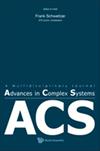高阶系统中的超矩阵代数与不可约性:概念与观点
IF 1
4区 数学
Q4 MATHEMATICS, INTERDISCIPLINARY APPLICATIONS
引用次数: 1
摘要
复杂性科学的理论和计算框架以二元结构为主。这种二元偏差,在数学模型中随处可见的成对网络和形式化二元运算中可见,限制了我们忠实地捕捉高阶系统中不可约多进相互作用的能力。高阶相互作用的一个典型例子是三个互锁环的博罗米恩环。在本文中,我们通过超图和超矩阵代数提出了一个数学框架,它允许以一种简洁的方式形式化这种形式的高阶键和连通性。我们的框架建立并扩展了高阶网络的现有技术——仍然主要植根于二进制结构,如邻接矩阵——并结合了高密度结构的最新发展,以阐明邻接超矩阵的组合行为。不可约的高阶相互作用在自然科学和社会文化知识表征中广泛存在。我们通过回顾计算机科学、物理、化学、生物学、生态学、社会科学和文化分析领域的最新成果,通过不可约高阶相互作用的概念透镜来证明这一点。我们进一步推测,在复杂系统中出现的一般现象可能以相互作用的时空差异为特征。本文章由计算机程序翻译,如有差异,请以英文原文为准。
Hypermatrix Algebra and Irreducible Arity in Higher-Order Systems: Concepts and Perspectives
Theoretical and computational frameworks of complexity science are dominated by binary structures. This binary bias, seen in the ubiquity of pair-wise networks and formal binary operations in mathematical models, limits our capacity to faithfully capture irreducible polyadic interactions in higher-order systems. A paradigmatic example of a higher-order interaction is the Borromean link of three interlocking rings. In this paper, we propose a mathematical framework via hypergraphs and hypermatrix algebras that allows to formalize such forms of higher-order bonding and connectivity in a parsimonious way. Our framework builds on and extends current techniques in higher-order networks — still mostly rooted in binary structures such as adjacency matrices — and incorporates recent developments in higher-arity structures to articulate the compositional behavior of adjacency hypermatrices. Irreducible higher-order interactions turn out to be a widespread occurrence across natural sciences and socio-cultural knowledge representation. We demonstrate this by reviewing recent results in computer science, physics, chemistry, biology, ecology, social science, and cultural analysis through the conceptual lens of irreducible higher-order interactions. We further speculate that the general phenomenon of emergence in complex systems may be characterized by spatio-temporal discrepancies of interaction arity.
求助全文
通过发布文献求助,成功后即可免费获取论文全文。
去求助
来源期刊

Advances in Complex Systems
综合性期刊-数学跨学科应用
CiteScore
1.40
自引率
0.00%
发文量
121
审稿时长
6-12 weeks
期刊介绍:
Advances in Complex Systems aims to provide a unique medium of communication for multidisciplinary approaches, either empirical or theoretical, to the study of complex systems. The latter are seen as systems comprised of multiple interacting components, or agents. Nonlinear feedback processes, stochastic influences, specific conditions for the supply of energy, matter, or information may lead to the emergence of new system qualities on the macroscopic scale that cannot be reduced to the dynamics of the agents. Quantitative approaches to the dynamics of complex systems have to consider a broad range of concepts, from analytical tools, statistical methods and computer simulations to distributed problem solving, learning and adaptation. This is an interdisciplinary enterprise.
 求助内容:
求助内容: 应助结果提醒方式:
应助结果提醒方式:


